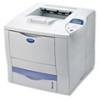Brother International HL-7050N Network Users Manual - English - Page 114
LAT NETWORK CONFIGURATION 9 - 9, that you may want to replace with your own designation.
 |
UPC - 012502603375
View all Brother International HL-7050N manuals
Add to My Manuals
Save this manual to your list of manuals |
Page 114 highlights
This will create 16 devices numbered sequentially. For example, it will create tty00 through tty15 if you have not previously created any terminal devices. To create an additional 16 devices, type: MAKEDEV lta1 3 Edit the /etc/ttys file to add a line similar to the following for each LAT connection: tty05 "etc/getty std.9600" vt100 off nomodem #LAT (substitute your actual tty number in place of tty05). 4 Verify that you have created valid LAT tty devices with the command: file /dev/tty* | grep LAT Valid LAT devices will have a "39" in the description that is printed when this command is executed. 5 Edit the /etc/printcap file to define the printer. The following is an example of an entry: lp1|BRN1:\ :lp=/dev/tty05:\ :ts=BRN_310107:\ :op=P1:\ :fc#0177777:fs#023:\ :sd=/usr/spool/lp1: lp1 in the example is the printer name; you may choose to replace it with a name of your choice. Likewise, BRN1 is a secondary name that you may want to replace with your own designation. The op parameter is the port name (P1). You must change the ts parameter to be the actual node name of your print server (the default node name is BRN_xxxxxx, where xxxxxx is the last six digits of the MAC address (Ethernet address)). You must also change the tty05 entry in the lp parameter to be the actual tty port you are using. The fc and fs parameters should be entered exactly as shown above since they are required for the output to be printed correctly. LAT NETWORK CONFIGURATION 9 - 9















